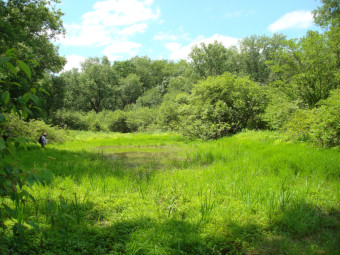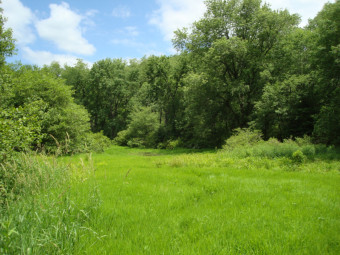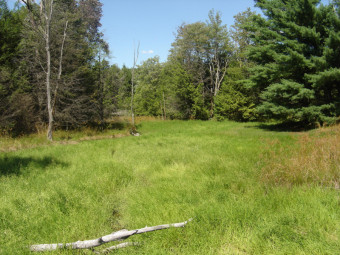Rice Cutgrass – Bulrush Vernal Pool
System: Palustrine
Subsystem: Herbaceous
PA Ecological Group(s):
Vernal Pool
Global Rank:GNR
![]() rank interpretation
rank interpretation
State Rank: S2?
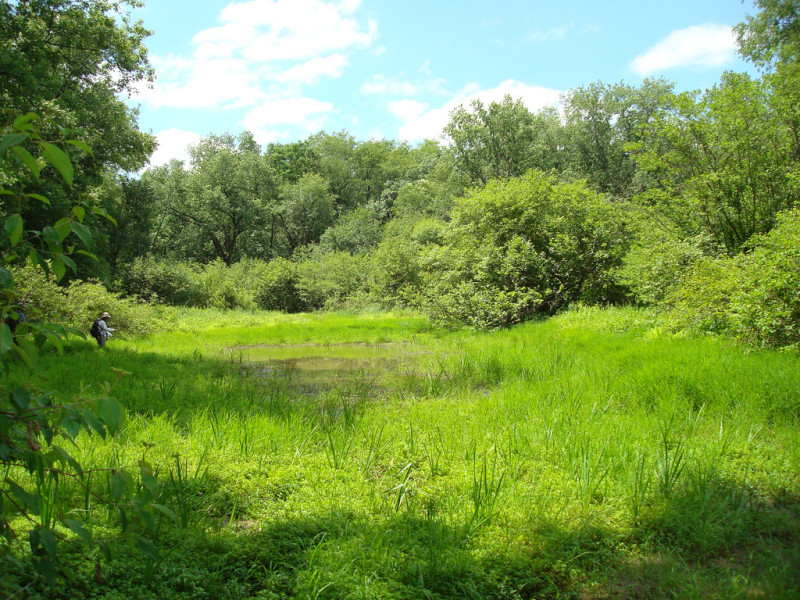
General Description
This community is characterized as an open, seasonally flooded, mixed-herbaceous wetland meadow with defined basin boundaries and usually occurs within dry, oak-dominated forests with open canopies. Common dominant species include pale meadowgrass (Torreyochloa pallida), mannagrass (Glyceria acutiflora), rattlesnake mannagrass (Glyceria canadensis), three-way sedge (Dulichium arundinaceum), Canada bluejoint (Calamagrostis canadensis), rice cutgrass (Leersia oryzoides), sedges (e.g. Carex tribuloides, C. lurida, C. gynandra, C. vesicaria, C. folliculata), dotted smartweed (Persicaria punctata), marsh St. Johns-wort (Triadenum fraseri), royal fern (Osmunda regalis), needle spike-rush (Eleocharis acicularis), and white beak-rush (Rhynchospora alba). The federally endangered species, northeastern bulrush (Scirpus ancistrochaetus), is also found in this type, and can sometimes comprise a significant area within the pool. The invasive low smartweed (Persicaria longiseta) was present within this type in some pools and stiltgrass (Microstegium vimineum), can form dense patches on the edges of the pools. Shrubs such as winterberry (Ilex verticillata) and swamp dewberry (Rubus hispidus) are present, but never dominant and canopy trees most often include white oak (Quercus alba), sourgum (Nyssa sylvatica), and red maple (Acer rubrum). The pools may also contain a substantial bryophyte layer that includes several species of peat moss (Sphagnum); there is relatively little area not covered by vegetation.
Rank Justification
Imperiled in the state because of rarity due to very restricted range, very few populations (often 20 or fewer), steep declines, or other factors making it very vulnerable to extirpation.
Identification
- Open, seasonally flooded depression, dominated by herbaceous plants, usually graminoids
- Occurs in seasonally inundated depressions most often on saddles between ridges and high plateaus within the Central Appalachian Forest Ecoregion in Pennsylvania
- Generally shallow, composed of several herbaceous species, and usually dry completely over the summer months, allowing herbaceous species to establish throughout the pool
- Northeastern bulrush (Scirpus ancistrochaetus), is also found in this type, and can sometimes comprise a significant area within the pool
Herbs
- Pale meadowgrass (Torreyochloa pallida)
- Mannagrass (Glyceria acutiflora)
- Rattlesnake mannagrass (Glyceria canadensis)
- Three-way sedge (Dulichium arundinaceum)
- Canada bluejoint (Calamagrostis canadensis)
- Rice cutgrass (Leersia oryzoides)
- Sedge (Carex tribuloides)
- Sedge (Carex lurida)
- Sedge (Carex gynandra)
- Sedge (Carex vesicaria)
- Sedge (Carex folliculata)
- Dotted smartweed (Persicaria punctata)
- Marsh st. johns-wort (Triadenum fraseri)
- Royal fern (Osmunda regalis)
- Needle spike-rush (Eleocharis acicularis)
- White beak-rush (Rhynchospora alba)
- Northeastern bulrush (Scirpus ancistrochaetus)
- Low smartweed (Persicaria longiseta)
Bryophytes
* limited to sites with higher soil calcium
Vascular plant nomenclature follows Rhoads and Block (2007). Bryophyte nomenclature follows Crum and Anderson (1981).
International Vegetation Classification Associations:
USNVC Crosswalk:None
Representative Community Types:
Central Appalachian Mountain Pond (Threeway Sedge - Buttonbush Type) (CEGL003746)
Seasonally Flooded Mixed Graminoid Meadow (CEGL006519)
NatureServe Ecological Systems:
None
NatureServe Group Level:
None
Origin of Concept
Leppo, B., Zimmerman, E., Ray, S., Podniesinski, G., and Furedi, M. 2009. Pennsylvania Statewide Seasonal Pool Ecosystem Classification: Description, mapping, and classification of seasonal pools, their associated plant and animal communities, and the surrounding landscape. Pennsylvania Natural Heritage Program, Western Pennsylvania Conservancy, Pittsburgh, PA.
Pennsylvania Community Code*
HV : Herbaceous Vernal Pond
*(DCNR 1999, Stone 2006)
Similar Ecological Communities
The Wool-grass – Mannagrass Mixed Shrub Marsh also occurs in seasonally to somewhat permanently inundated depressions throughout Pennsylvania. This type differs from the Rice cutgrass – Bulrush Marsh vernal pool type in that it is generally deeper than the Rice cutgrass – Bulrush Marsh and may not dry completely over the summer months and that some examples of this type are more “marsh-like” and exhibit somewhat poorly defined boundaries. Shrub species typically are more prevalent in the Wool-grass – Mannagrass Mixed Shrub Marsh type than in the Rice cutgrass – Bulrush Marsh.
Fike Crosswalk
Related to Herbaceous Vernal Pool. This type is new to the Pennsylvania Plant Community Classification developed fromstudies of vernal pool ecosystems of Pennsylvania.
Conservation Value
Vernal pools are primarily found in forested areas and are characterized by absence of fish, lack of flowing water, small size, shallow depth, and presence of plants and animals that can withstand a period of drought (Brown and Jung 2005). Their seasonal nature is important because it excludes fish that would otherwise prey upon the eggs and larvae of amphibians breeding in them.
In the mid-Atlantic states, 26 percent of all state-listed threatened and endangered amphibians are dependent on vernal pools.
Vernal pools provide critical breeding habitat for several species of amphibians and a type of crustacean that use vernal pools almost exclusively during some stage of their life cycle. The amphibian species are:
- Marbled Salamander (Ambystoma opacum)
- Spotted Salamander (Ambystoma maculatum)
- Jefferson Salamander (Ambystoma jeffersonianum)
- Wood Frog (Rana sylvatica)
- Eastern Spadefoot (Scaphiopus holbrookii holbrookii)
- Springtime Fairy Shrimp (Eubranchipus vernalis).
A plant species found only in vernal pools in Pennsylvania is the northeastern bulrush (Scirpus ancistrochaetus).
Threats
Threats include habitat fragmentation, alteration of hydrology and water chemistry, alteration of substrate, loss of vegetation, and global climate change.
Filling vernal pools, and disturbances to the vegetation and soil around pools from building and road construction, quarries, and logging operations lead to direct mortality of animals and habitat destruction or degradation. Vernal pools are often not identified as wetlands due to their temporary nature.
Clearing and development of adjacent land can lead to accumulation of agricultural run-off and pollution, sedimentation, and pollution in the pools. Removal or change in composition of vegetation in and around a pool affects which species can use the pool. For species that lay their eggs in plant material, loss of vegetation eliminates egg-laying sites. For species that lay their eggs in the water, removal of vegetation reduces shade.
Roads near vernal pools present a physical obstacle to animals moving from their upland feeding habitats to their vernal pool breeding habitats. Many animals are killed as they attempt these crossings. The presence of roads also provides opportunities for undesirable elements to get into the pools. Roads bring invasive plant species, sediments, and contaminants to pools through runoff. During the winter the application of road salt poses a problem for pools located near roads. As the snow melts, salt-laden water flows into these pools and increases the salinity of the water, making the water less hospitable to wildlife.
All aspects of life in a vernal pool, from amphibian migration to egg and larval development to adult feeding, thermoregulation, and reproductive success, depend on certain environmental cues and conditions. Climate change is of increasing concern for species of special concern, especially in regard to species that are geographically restricted.
Management
A natural buffer around the wetland should be maintained in order to minimize nutrient runoff, pollution, and sedimentation. Protecting vernal pools and the surrounding 1000 feet of upland habitat is critical for protection of water quality, amphibian breeding, and terrestrial habitat for adult and juvenile amphibians. Soil erodibility in terms of the soil texture, condition of the adjacent vegetation (mature forests vs. clearcuts) and the topography of the surrounding area (i.e. degree of slope) should be considered when establishing buffers. Impervious surfaces surrounding the wetland should be minimized to prevent thermal pollution. Direct impacts and habitat alteration should be avoided (i.e. roads, trails, filling of wetland) and low impact alternatives (i.e. elevated footpaths, boardwalks, bridges) should be utilized in situations where accessing the wetland can not be avoided. Care should also be taken to control and prevent the spread of invasive species within the wetland.
Research Needs
There is a need to collect community plot data to characterize variations of this community to assist further classification of this community.
Trends
These wetlands were probably more common but declined due to wetland draining/filling and clearing of the adjacent lands leading to increased evaporation of the standing water and sedimentation.
Range Map
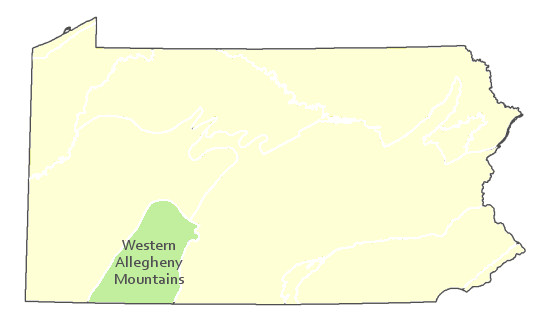
Pennsylvania Range
Central Appalachian Forest Ecoregion in Pennsylvania
Global Distribution
Brown, L. J. and R.E. Jung. 2005. “An introduction to Mid-Atlantic Seasonal Pools,” EPA-903-B-05-001. U.S. Environmental Protection Agency, Mid-Atlantic Integrated Assessment, Ft. Meade, Maryland. epa.gov/bioiweb1/pdf/EPA-903-B-05-001AnIntroductiontoMid-AtlanticSeasonalPools.pdf
Fike, J. 1999. Terrestrial and Palustrine Plant Communities of Pennsylvania. Pennsylvania Natural Diversity Inventory. Harrisburg, PA. 87pp.
Hulse, A.C., C. J. McCoy and E. J. Censky. 2001. Amphibians and Reptiles of Pennsylvania and the Northeast. Cornell University Press, New York. 419 pp.
Leppo, B., Zimmerman, E., Ray, S., Podniesinski, G., and Furedi, M. 2009. Pennsylvania Statewide Seasonal Pool Ecosystem Classification: Description, mapping, and classification of seasonal pools, their associated plant and animal communities, and the surrounding landscape. Pennsylvania Natural Heritage Program, Western Pennsylvania Conservancy, Pittsburgh, PA.
NatureServe. 2009. NatureServe Explorer: An online encyclopedia of life [web application]. Version 7.1. NatureServe, Arlington, Virginia. Available: http://www.natureserve.org/explorer. (Accessed: March 10, 2010 ).
Pennsylvania Department of Conservation and Natural Resources (DCNR). 1999. Inventory Manual of Procedure. For the Fourth State Forest Management Plan. Pennsylvania Bureau of Forestry, Division of Forest Advisory Service. Harrisburg, PA. 51 ppg.
Pennsylvania Herp Identification: Online Guide to Reptiles and Amphibians of Pennsylvania: paherps.com/herps
Pennsylvania Herpetological Atlas: paherpatlas.org
Pennsylvania Seasonal Pool Registry: WaterLandLife.org/54
Stone, B., D. Gustafson, and B. Jones. 2006 (revised). Manual of Procedure for State Game Land Cover Typing. Commonwealth of Pennsylvania Game Commission, Bureau of Wildlife Habitat Management, Forest Inventory and Analysis Section, Forestry Division. Harrisburg, PA. 79 ppg.
The Nature Conservancy’s Vernal Pools Web site: nature.org/pavernalpools
Cite as:
Zimmerman, E. 2022. Pennsylvania Natural Heritage Program. Rice Cutgrass – Bulrush Vernal Pool Factsheet. Available from: https://naturalheritage.state.pa.us/Community.aspx?=30028 Date Accessed: January 11, 2026

